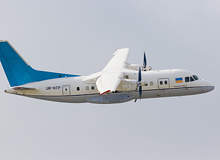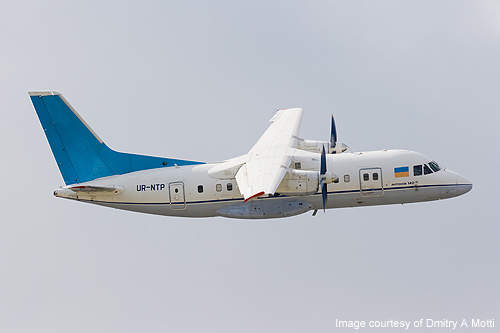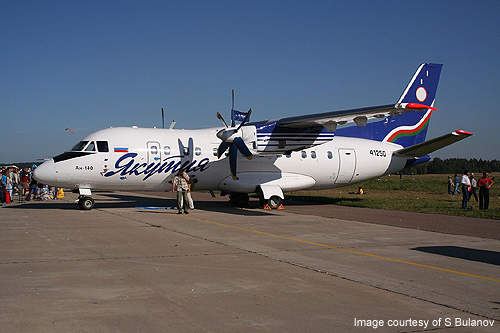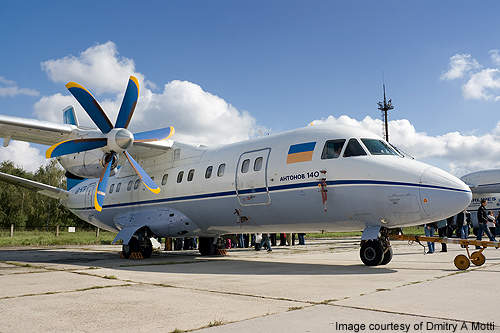The An-140 is a twin-engine passenger / cargo aircraft designed and developed by Antonov ASTC of Ukraine to operate in the regional air routes. It was built to replace the An-24 aircraft which was operational since 40 years. A total of 25 An-140s were operational worldwide as of August 2010.
Variants
The An-140 has six variants which include An-140-100, An-140A, An-140T, An-140TK, An-140VIP Executive and An-142.
The An-140-100 is a military version built in 2003 to supersede the ageing An-24, An-26 and Yak-40. This variant executes maritime patrol, medical, aerial photography, geological exploration, freight and fishery exploration missions. It features a lengthened fuselage, higher maximum take-off weight and longer range.
The An-140A is an advanced version of An-140, powered by a Pratt & Whitney PW127A turboprop engine.
The An-140T is a freight model powered by TV3-117-SBM3 engine. Deployed by the Russian Navy, the variant is equipped with a large cargo door on the rear fuselage.
The An-140VIP carries 30 passengers onboard.
Orders and deliveries
The orders received for An-140 from various customers include: Antonov Airlines (three), Ilyich-Avia (two), Motor Sich (three), Air Libya Tibesti (five), Yakutia Airlines (eight), Russian Ministry of Defence (seven), Safiran Airlines (two), Iran Air Tours (eight) and Aeroflot (25).
The Russian Air Force ordered seven An-140s from Ukraine in May 2011, reported M&C.
Design
The An-140 is of conventional design and operates during both day and night even under worst climatic conditions. The AI9-3B auxiliary power unit integrated at the tail section of fuselage allows the aircraft to takeoff and land from semi-prepared airstrips, unpaved airfields, snow covered ice fields and short runways.
Development
The development of An-140 began in 1993 at Kharkov State Aircraft Production Plant in Ukraine. Production was also assigned to its partner AVIACOR Aviation Plant JS (Samara, Russian Federation). HESA plant obtained manufacturing license from Antonov in 1996 to produce the license built Iran-140 Faraz at Esfahan in Iran. Production is also expected to migrate to Kazakhstan.
Three An-140 prototypes were built, of which the first came from the Kiev Factory in June 1997. The prototype took off for its maiden flight in September 1997 and entered service in October 1999. The second prototype was introduced in 1998.
Features
The An-140 features a passenger entrance door with built-in stairs at the aft fuselage section. The aircraft is equipped with a freight door on the front starboard to load or unload the cargo. It also houses mating connector, wing navigation red light, air outlet, clamping ramp and warning horn supplied by Goodrich Corporation.
The aircraft is fitted with ventilation systems, multichannel entertainment systems, noise absorbing panels, a cargo hatch, cargo loading system and a robust tricycle landing gear comprising low pressure tires.
Flight deck
The flight deck accommodates two crew members: pilot and co-pilot. It is equipped with voice over recorder, weather radar, distance measuring equipment, automatic flight control system, magnetic compass, CO-72M transponder, CH-3301 global navigation satellite system, ground proximity warning system, emergency rescue radio station, emergency transmitter and environmental control system.
Cabin
The An-140 features a large cabin with plenty of space for passengers onboard. The cabin seats 52 passengers in a four abreast seating configuration. It is divided into three zones which include exclusive lounge boasting four seats, business class fitted with 22 seats and economy class with 26 seats.
The aircraft also boasts luggage and cargo compartments of 9.1m³ volume beneath the passenger cabin and in the aft fuselage section. It can accommodate 1.84t of freight, which is 1.3 to 1.5 times larger than the capacity of a conventional aircraft of the same category. Palletised cargoes can be placed in the front portion of the passenger cabin.
Engines
The An-140 is powered by two TV3-117VMA-SBM1 turboprop engines driven by two six-bladed AV-140 composite propellers. Each engine can generate 1,838kW of output power. The engines are manufactured by Ivchenko Progress Zaporozhye, Klimov Scientific Industrial Enterprise and Motor Sich.
The engine is 2.9m-long, 0.98m-wide and 1.2m-high. Its dry weight is 570kg.
Performance
The An-140 can climb at the rate of 6.8m/s. The maximum and cruise speeds of the aircraft are 575km/h and 460km/h respectively. The maximum range is 1,380km and the ferry range is 3,680km. The service ceiling is 7,600m. The take-off distance of the aircraft is 1,750m and the landing distance is 1,360m.
The aircraft can operate at ambient temperatures ranging between -550C and + 450C from airfields located 2,500m above the sea level.







